U.S. Department of Transportation
Federal Highway Administration
1200 New Jersey Avenue, SE
Washington, DC 20590
202-366-4000
FHWA-SA-15-052
View the PDF Version [1.07 MB]
You will need the Adobe
Reader to view this PDF.
|
 |
Four-lane undivided highways have a history of increased crashes as traffic volumes rise, due to motorists sharing the inside lane for higher speed through movements and left turns. Additionally, as active transportation increases, communities desire more livable spaces, pedestrian and bicycle facilities, and transit options, which are not easily accommodated by a 4-lane undivided roadway. One solution that benefits all modes is a Road Diet (Roadway Reconfiguration).
A Road Diet is generally described as removing vehicle lanes from a roadway and reallocating the extra space for other uses or travelling modes, such as parking, sidewalks, bicycle lanes, transit use, turn lanes, medians or pedestrian refuge islands.
Road Diets have the potential to improve safety, provide operational benefits, and increase the quality of life for all road users. Road Diets can be relatively low cost if planned in conjunction with reconstruction or resurfacing projects since applying Road Diets consists primarily of restriping.
For additional information about Road Diets, visit the FHWA Office of Safety Road Diets website at http://safety.fhwa.dot.gov/road_diets.
Improving safety is a top priority for the U.S. Department of Transportation, and the Federal Highway Administration (FHWA) remains committed to reducing highway fatalities and serious injuries on our Nation's roadways through the use of proven safety countermeasures, including Road Diets. Along with the development of the Road Diet Informational Guide, the FHWA Office of Safety commissioned a series of 24 case studies highlighting Road Diet implementations throughout the United States. The aim of this document is to provide State and local agencies and Tribal governments with examples and advice that can assist them in planning and implementing Road Diets in their own jurisdictions.
Many of the concepts described in this publication are illustrated in photographs and drawings. The drawings are for illustrative purposes only; they are not to scale and should not be used for design purposes. It is important to note that the lettering styles, arrows and symbols used in these case studies are not always consistent with those prescribed in the Manual on Uniform Traffic Control Devices (MUTCD). When employing treatments included in the case studies, only MUTCD-approved lettering styles, arrows and symbols should be used. Additionally, any highway agency wishing to implement a treatment that has not been included in the most recent edition of the MUTCD must request experimentation approval from the FHWA.
| Genesee County Metropolitan Planning Commission | Genesee County, Michigan | Communities Embrace Widespread Road Diet Use | Assessment and ranking of all 4-lane roads to determine Road Diet potential |
|---|---|---|---|
| City of Grand Rapids | Division Street Grand Rapids, Michigan |
Livability Improves as Number of Lanes Decreases | Trial-basis Road Diet; highlights the positive outcomes and trade-offs of Road Diets |
| City of Grand Rapids | Burton Street Grand Rapids, Michigan |
Road Diet and Transit Working Together |
Traffic congestion concerns; transit stops |
| City of Chicago | 55th Street Chicago, Illinois |
Road Diet Includes Parking-Separated Bicycle Lanes | Improving bicycle safety and connectivity while maintaining efficient bus operation |
| City of Chicago | Franklin Boulevard Chicago, Illinois |
Road Diet Improves Bicycle Connectivity, Enhances Livability | Livability benefits; improving safety and mobility for bicyclists |
| City of Chicago | Wabash Avenue Chicago, Illinois |
Capacity Improved After Road Diet | Before-and-after capacity analysis; buffered bicycle lanes; signal optimization |
| City of Pasadena | Cordova Street Pasadena, California |
Road Diet Improves Multimodal Level of Service | Improvement in multimodal level of service; addressing speeding issues |
| City of Santa Monica | Ocean Park Boulevard Santa Monica, California |
Road Diet Improves Safety Near School |
Addressing safety issues near school |
| City of Los Angeles | Seventh Street Los Angeles, California |
Road Diet: Key Ingredient in Los Angeles’ Bicycle Master Plan |
Improving bicycle mobility and encouraging bicycle ridership |
| Virginia Department of Transportation | Lawyers Road Reston, Virginia |
All-Around Success for Safety and Operations |
Community input and public perception survey; crash reduction; bicycle connectivity |
| Virginia Department of Transportation | Soapstone Drive Reston, Virginia |
There’s More Than One Way to Complete a Road Diet | Multiple configurations of Road Diets; crash reduction; bicycle connectivity |
| Virginia Department of Transportation | Oak Street Dunn Loring, Virginia |
Improving Safety and Livability | Reducing aggressive driving behaviors; providing consistent lane configuration |
| City of Des Moines | Ingersoll Avenue Des Moines, Iowa |
Temporary Road Diet Becomes Permanent |
Trial-basis Road Diet; public perception survey |
| Regional Transportation Commission of Washoe County | Reno, Nevada | Educating the Public on Road Diets | Public outreach method for education on Road Diet projects |
| Regional Transportation Commission of Washoe County | California Avenue Reno, Nevada |
A Feasibility Evaluation Using Traffic Simulation Software |
Using traffic simulation software to determine feasibility of a Road Diet |
| Regional Transportation Commission of Washoe County | Wells Avenue Reno, Nevada |
Road Diet Improves Safety for Motorized and Non-motorized Users | Evaluating the safety and operational effects of the Road Diet |
| New York City Department of Transportation | Luten Avenue Staten Island, New York |
Safety Solution Near School is a Road Diet |
Addressing safety issues near school; reducing speeds |
| New York City Department of Transportation | Ninth Avenue Manhattan, New York |
Road Diet on One-Way Street Designed for All Users | One-way street; parking-separated bicycle path; bicycle signals; pedestrian refuge islands |
| New York City Department of Transportation | Empire Boulevard Brooklyn, New York |
Road Diet Improves Pedestrian Safety |
Increasing pedestrian safety; reducing speeds and calming traffic |
| New York City Department of Transportation | West Sixth Street Brooklyn, New York |
NYCDOT Responds to Tragedy with Road Diet |
Addressing pedestrian safety issues |
| Seattle Department of Transportation | Dexter Avenue Seattle, Washington |
Two-Stage Road Diet | 4-lane to 3-lane to 2-lane Road Diet; bus bulb-outs, buffered bicycle lanes; high bicyclist volume and bus ridership |
| Seattle Department of Transportation | Nickerson Street Seattle, Washington |
Safety Improved & Extreme Speeding Virtually Eliminated | Reducing speeds; improving overall safety; pedestrian safety features |
| Seattle Department of Transportation | Stone Way Seattle, Washington |
Despite Early Opposition, Road Diet Produces Great Results |
Public sentiment on Road Diet project; increased bicycle use |
| City of Indianapolis | Indianapolis Cultural Trail Indianapolis, Indiana |
Road Diets Lead to Economic Development |
Public outreach, planning, and design; economic development success |
COMMUNITIES EMBRACE WIDESPREAD ROAD DIET USE
| Objective | Features | Results |
|---|---|---|
|
|
|
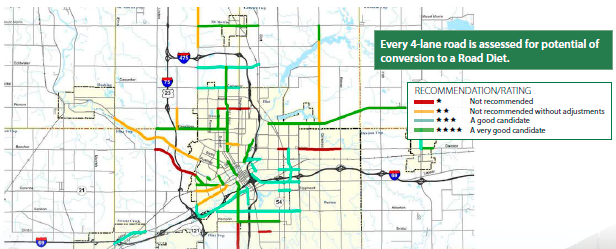
Since 2009, Road Diets have rapidly become culturally accepted in Michigan, and agencies are scouring their systems to identify which 4-lane roads are the best candidates for a Road Diet.
Genesee County Metropolitan Planning Commission (GCMPC), encompassing one county and 33 municipalities, has been both progressive and aggressive with Road Diet installations. Since the introduction of this safety treatment to the public, the GCMPC set out to make Road Diets a positive treatment in the community's eyes. The 4- to 3-lane Road Diet conversions in the county have been so successful that citizens now favor the 3-lane cross section where it is operationally feasible.
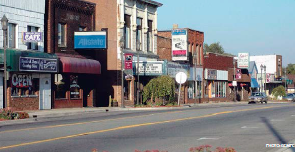
City of Clio.
The GCMPC stated that...
"Road Diets are seen as treatments that can be used to keep a downtown area 'current' and follow the national [livability] trends."
The real boost to widespread implementation of Road Diets in the region occurred in 2009 with the adoption of a Complete Streets program and completion of a technical study in which the GCMPC assessed every 4-lane road in its jurisdiction for potential of conversion to 3 lanes, ranking the desirability of each for Road Diet consideration.
In the beginning, routes with lower volumes (6,000 to 8,000 vehicles per day) were targeted in order to allow for easy conversion, and the results included immediate safety benefits. After several successful conversions with positive outcomes, GCMPC began selecting implementation sites with higher volumes – up to 15,000 vehicles per day.
GCMPC has encouraged local agencies in the county to try out a low-cost Road Diet by restriping existing 4-lane segments to three lanes as part of their ongoing restriping plans. After a trial period, if the conversion is not operating as desired or publicly accepted, the road can be restriped back to the original layout.
GCMPC uses an educational approach to gain public support for Road Diets. Selecting appropriate Road Diet locations within the county based on engineering studies is the first step. The GCMPC then approaches individual city agencies about the potential Road Diet corridor and educates the stakeholders on the benefits. This collaboration begins early in the planning process and continues through the Road Diet installation. Working together with these stakeholders gives a sense of project awareness and buy-in to all involved, and it helps to overcome obstacles that arise along the way, leading to smoother implementation.
Road Diet installations have improved safety in Genesee County. Analyzing the traffic crash data from 1996 to 2007, the GCMPC completed a before-and-after safety study using seven Road Diet sites, with results showing an overall reduction of crashes.
| Crash Type | Davison Rd. | Dupont St. | Flushing/Fifth Ave. | ML King Jr Blvd | Miller Rd. | University Ave. | Vienna Rd. | Overall |
|---|---|---|---|---|---|---|---|---|
| Head-on | -17% | -31% | -100% | 129% | -43% | -100% | -62% | -32% |
| Head-on Left Turn | -28% | -74% | -100% | -41% | -37% | -100% | -24% | -58% |
| Rear End | -16% | -54% | -29% | -46% | -29% | -53% | -21% | -35% |
| Rear End Left Turn | -92% | -79% | -100% | -17% | -37% | -100% | -13% | -36% |
| Side Swipe Same Side | -18% | -56% | -48% | -42% | -15% | -31% | -20% | -33% |
| Side Swipe Opposite Side | -31% | -5% | -100% | -17% | -33% | -100% | -55% | -39% |
| All Non-alcohol & Non-deer | -16% | -47% | -42% | -38% | -23% | -35% | -26% | -32% |
LIVABILITY IMPROVES AS NUMBER OF LANES DECREASES
| Objective | Features | Results |
|---|---|---|
|
|
|
LIVABILITY: Tying the quality and the location of transportation facilities to opportunities such as access to good jobs, affordable housing, quality schools and safer streets.

Division Street has on-street parking and signals at every intersection through downtown
The City of Grand Rapids has taken a holistic view of Road Diet implementations by identifying all 4-lane facilities within its jurisdiction, and then recording and tracking traffic volumes, corridor use, and the overall operation under existing conditions. The city recognizes the safety benefits of Road Diets and is aware of a roadway reconfiguration's potential effect on traffic operations They also recognize that Road Diets can bring a higher quality of life for users and can encourage commercial activity and sales.
This approach led the City of Grand Rapids to install a Road Diet on Division Street, from I-196 to Wealthy Street. The roadway's cross section changed from four and five vehicle lanes to three lanes and a mixture of dedicated bicycle lanes and shared lanes. Although on-street parking already existed prior to the Road Diet, the reconfiguration allowed for additional parking spots.
The city conducted two public meetings before this Road Diet was implemented to gain public support and to educate those who use the route. During these meetings, officials learned that citizens wanted the opportunity to try the Road Diet for a trial period and reconvene before implementing permanently.
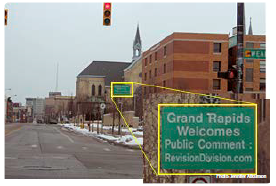
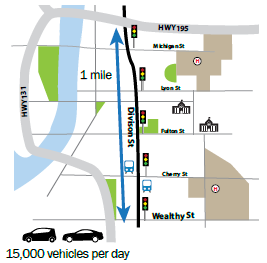
After the Division Street Road Diet installation, the City of Grand Rapids reported that businesses along the corridor are generally happy with the project because of the perceived improvement in the quality of life attributes and livability of the community. A few residential facilities along Division Street that were previously unrented for 2 years have been rented after the Road Diet brought improved bicycle accessibility. The owner of those housing facilities believes that the bicycle enthusiasts who want to live along the corridor and bike to work have contributed to an overall increase in economic activity in the area.
One lesson the city learned from this project was the need to carefully evaluate the potential effects Road Diets could have on the reliability of transit schedules. Before installation, Division Street served as a local transit route. However, the bus company decided to relocate the route to another corridor after the Road Diet because of increased travel times.
Based on positive public feedback, the City of Grand Rapids ultimately chose to retain the Road Diet permanently. While the Road Diet project produced many positive outcomes, the project resulted in some negative aspects as well. The benefits and trade-offs are summarized in the following table.1
| Positive Outcomes | Trade-offs |
|---|---|
| Increased parking | Increased delay |
| Decreased vehicle speeds (-1 to -4 mph) | Longer queues (i.e., Northbound increased from 81 feet before to 180 feet after in the PM) |
| Improved bicycle facilities (bike lanes/shared lanes) | Longer travel times (average increase of 19 to 52 seconds through corridor) |
| Reduction in head-on left turn (-38%)*, angle (-17%), and sideswipe crashes (-20%) | Rear-end crashes nearly tripled after installation |
| Increased pedestrian/bicycle flow (+13% PM, +57% off-peak, and -14% AM) | Increased emissions (+19.8% AM, +1.1% off-peak, and -5.3% PM) |
| Decreased volumes (-18% to -29% north of Wealthy St.) | Diversion from the corridor |
| *Calculated from data in the referenced Report (eight crashes before to five crashes after; this percentage varies from the percentage published in the report table. | |
1City of Grand Rapids, Michigan, "Revision Division Road Diet Traffic Impact Study: Final Report," February 2013.
ROAD DIET AND TRANSIT WORKING TOGETHER
| Objective | Features | Results |
|---|---|---|
|
|
|
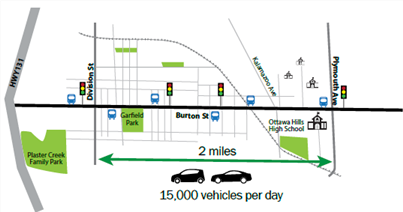
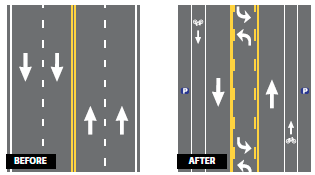
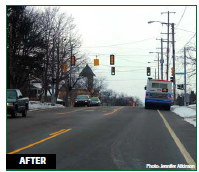
In 2012, the City of Grand Rapids, Michigan, installed a Road Diet on Burton Street stretching from Division Street to Plymouth Avenue. At just over 2 miles long with a mix of residential and commercial businesses, this segment of Burton Street experiences approximately 15,000 vehicles per day and is home to several schools and a public park. In addition to buses transporting students to school, a transit route also runs along this section.
Although recent Road Diets in Grand Rapids had proved successful, there were still apprehensions when the city announced the Burton Street Road Diet conversion. Opponents were worried that traffic congestion might occur as a result of the frequent stops of school and transit buses traveling within the corridor.1 Residents in the area were also concerned about having sufficient gaps to turn onto Burton Street at stop-controlled intersections. Rick DeVries, Assistant City Engineer, was well aware of the traffic congestion concerns brought to the city's attention, "You try to balance what you're trying to do safety-wise, and quality of life, with those kinds of concerns."2
Public Opinion:3" I believe in both improving our road's safety and increasing the bike friendliness of Grand Rapids. The Burton road diet brings the best of both worlds."
The city needed a solution that addressed the concern that frequent bus stops might contribute to traffic congestion if Burton Street underwent a Road Diet. While transit stops are often equipped with bus pull-offs, transit providers in the area indicated they prefer to not remove the bus completely from the travel lane, as it interferes with their ability to merge back into mainline traffic. In response, the city's Road Diet design included the addition of a designated bicycle lane that served a dual purpose: it accommodated Burton Street bicycle traffic and provided a place for transit buses to make routine stops. Transit buses are able to utilize the bicycle lane during stops and still leave the majority of the through lane available for motorists behind the bus to use if they desire. This practical solution met the needs of the transit providers in the area while also improving the roadway for bicyclists.

To further address congestion concerns, the city optimized the traffic signal timing along the corridor, improving the progression of traffic and allowing motorists to more easily access Burton Street at stop-controlled intersections by providing gaps in traffic.
In the end, those living along Burton Street are enjoying the slower speeds and bicycle lanes the Road Diet has provided.
1 Zane McMillin, "Grand Rapids leaders make case for Burton Street 'diet' as business owners cry foul," mLIVE, January 10, 2012. Assessed March 23, 2015. Available at: http://www.mlive.com/news/grand-rapids/index.ssf/2012/01/grand_rapids_leaders_make_ case.html
2 Ibid.
3 Comment from Amy Baas on "Move forward with planned Burton Street (Grand Rapids, MI) Road Diet," an online petition posted by Joshua Leffingwell. Accessed March 23, 2015. Available at: https://www.change.org/p/bike-friendly-gr-move-forward-with-planned-burton-street-grand-rapids-mi-road-diet/reasons_for_signing
ROAD DIET INCLUDES PARKING-SEPARATED BICYCLE LANES
| Objective | Features | Results |
|---|---|---|
|
|
|
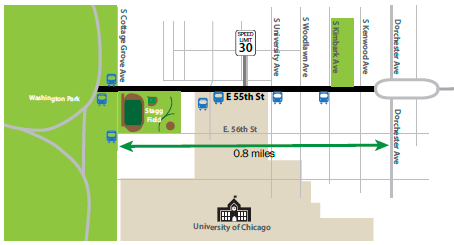

In 2011, an announcement from Chicago's mayor that the city would install 100 miles of separated bicycle lanes was the starting point that led to the Road Diet on 55th Street. From Cottage Grove Avenue to Dorchester Avenue, this 0.8-mile segment of roadway runs along the University of Chicago campus and ends on the west end at Washington Park. This Road Diet transformed a 4-lane roadway with parking on both sides to a 3-lane roadway with parking-separated bicycle lanes. The land use along 55th Street is primarily a mix of institutional, residential, commercial, and service uses, including a fire station.
The University of Chicago buildings and athletic fields abut 55th Street on one side, and a service drive parallels a portion of this corridor.
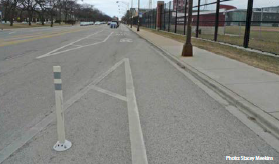 Bus Entry |
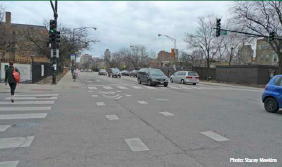 Bus stop and shared lane at intersection, through intersection markings |
The Chicago Transit Authority (CTA) has a primary bus route along this corridor, with headways ranging from 5 to 20 minutes throughout the day. The city coordinated extensively with the CTA on the design of the Road Diet. The overall design and layout of the bus stops in coordination with the separated bicycle lanes was a critical issue to maintain efficient bus operation.
The addition of bicycle lanes is a great advantage to university of Chicago students, staff, and visitors
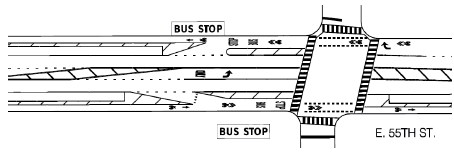
The 55th Street Road Diet experienced the following results after installation.
ROAD DIET IMPROVES BICYCLE CONNECTIVITY, ENHANCES LIVABILITY
| Objective | Features | Results |
|---|---|---|
|
|
|
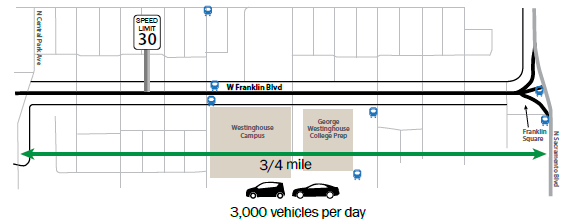

As part of Chicago's plan to expand the mileage of bicycle lanes, the ¾-mile Road Diet on Franklin Boulevard from Sacramento Boulevard to Central Park Avenue transformed a 4-lane roadway to a 3-lane roadway with separated bicycle lanes in each direction.
Franklin Boulevard has good access management, with limited intersecting roadways and parallel one-way service roads alongside the main throughway separated by a planted median. The sidewalks serving the neighborhood are located along the service roads. The land use along Franklin Boulevard is primarily residential but also contains two schools, a veterans home, and a hospital.
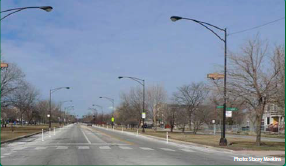 3-lane cross-section with bollard-separated bicycle lanes |
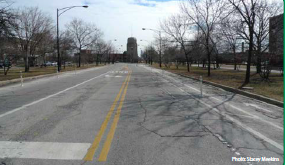 Cross-section at an all-way stop intersection |
With Franklin Boulevard's relatively low average daily traffic (ADT) of approximately 3,000 vehicles, traffic congestion was not an issue on this corridor. The reason for this Road Diet conversion was due to Chicago's plans to further expand and connect the bicycle facilities throughout the city. The project allowed for the installation of bicycle lanes with a buffer space delineated with vertical bollards to separate vehicles and bicycles.
The biking community has been excited and supportive of Chicago's overall expansion plans, "Thanks to these new facilities, Chicago's streets have never been safer for people on bicycles. And people of all ages are taking their first bicycle ride in years, further expanding Chicago's bicycling community and helping us build momentum for better cycling conditions."1
"Chicago's streets have never been safer for people on bikes"
Speeding and congestion were not issues for this corridor before or after the conversion, but the Road Diet produced positive "livability" or "quality of life" changes, such as:
CAPACITY IMPROVED AFTER ROAD DIET
| Objective | Features | Results |
|---|---|---|
|
|
|
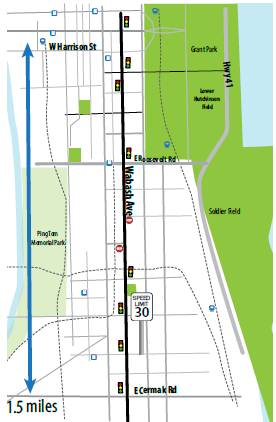
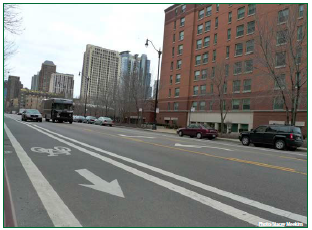
Buffered Bicycle lane
Developing bicycle lanes along Wabash Avenue as part of Chicago's bicycle plan implementation was the city's primary reason for the 1.5-mile Road Diet from Cermak Road to Harrison Street. The cross section of this corridor was originally 4-lanes with on-street parking. It was converted to a 3-lane cross section with on-street parking and buffered bicycle lanes on both sides.
Located just south of Chicago's main business district, "The Loop," the land use on Wabash Avenue is a combination of commercial and service-oriented businesses, as well as institutional, with a college being located in the area. Intersections along the 30-mph corridor are mostly controlled by traffic signals with the exception of two T-intersections that are all-way stop-controlled.
Scheduled to undergo a phased resurfacing plan, the city took the opportunity to install buffered bicycle lanes along Wabash Avenue when the corridor was re-striped. Just north of the entire corridor, Wabash is a one-way street, which provided a logical terminus for the bicycle lanes and the Road Diet. The striping plans created separation between vehicles and vehicles and bicycles with a 2-ft wide painted buffer zone, and it allowed for the addition of left-turn lanes at the intersections. The traffic signals along Wabash Avenue also underwent a signal optimization with the Road Diet conversion to mitigate any traffic operations concerns.
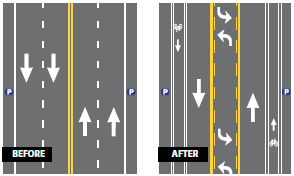
A capacity analysis using simulation software revealed that capacity improved along Wabash Avenue after installation of the Road Diet and signal optimization.
ROAD DIET IMPROVES MULTIMODAL LEVEL OF SERVICE
| Objective | Features | Results |
|---|---|---|
|
|
|
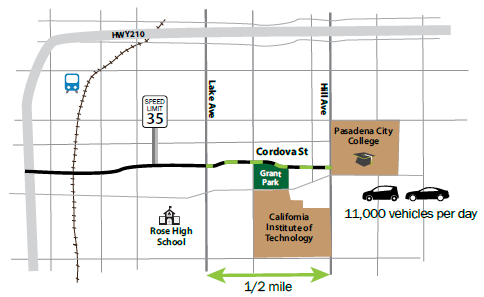
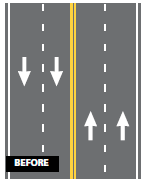 |
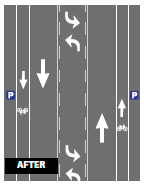 |
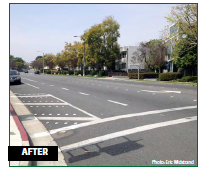 Cordova St at Chester Ave looking west |
With the intent to reduce speeds and improve safety, the City of Pasadena completed a Road Diet in June 2010 on Cordova Street in conjunction with a repaving project. In support of the city's Bicycle Master Plan, the project spanned just over one-half mile, from Lake Avenue to Hill Avenue and provided bicycle lanes along the corridor.
Located adjacent to the Central Business district, Cordova Street includes multi-family residential and commercial property and is home to a private school, park, and community college along the Road Diet corridor. Cordova Street carries approximately 11,000 vehicles per day, with AM and PM peak hour traffic volumes varying between 600 and 1,000 vehicles.
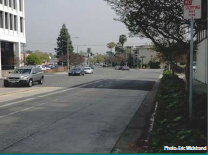 Cordova St. looking east |
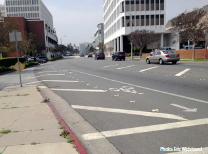 Cordova St at Mentor Ave looking west toward Lake Ave |
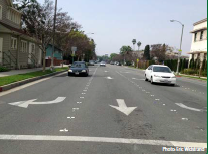 Cordova St at Hill Ave cross section |
Using funds from the American Recovery and Reinvestment Act, a basic repaving project planned for Cordova Street allowed for the Road Diet conversion and helped fulfill the city's goal of installing bicycle lanes and enhancing existing curb parking along this corridor.
The City of Pasadena conducted outreach through the city council's office and the city's website prior to beginning the transformation.
"Pasadena is always looking for new ways to provide non-vehicular alternative modes of travel to its citizens," said city Transportation Director Fred Dock. "This project will serve the bicyclists traveling between the South Lake District and Pasadena City College, making it safer for pedestrians to cross at intersections and potentially reducing the driving speed of motorists."1
Preceding this project, there had been some speeding issues on Cordova Street, and because of safety concerns residents had requested the installation of additional traffic signals to help pedestrians cross the street. The Road Diet was able to benefit pedestrians without installing new traffic signals by removing two through lanes of traffic and adding painted curb extensions at intersections, providing ample opportunities to cross at unsignalized intersections along the corridor.
A before-and-after study completed in late 2011 examined traffic speeds, volumes, safety, and the multimodal level of service. The results showed an improved bicycle level of service and no changes to pedestrian or vehicular levels of service along the corridor. There was also a slight reduction in total collisions and injuries. After the Road Diet, traffic speeds were reduced and compliance with the posted speed limit increased.
ROAD DIET IMPROVES SAFETY NEAR SCHOOL
| Objective | Features | Results |
|---|---|---|
|
|
|
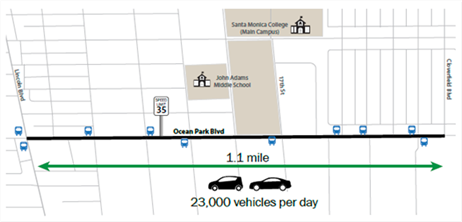
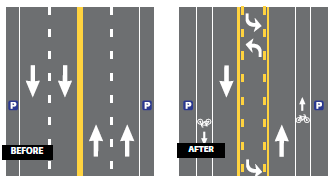
The City of Santa Monica installed an interim Road Diet on Ocean Park Boulevard in 2008 with hopes of improving safety for pedestrians and bicyclists in the area. Extending 1.1 miles, from Lincoln Boulevard to Cloverfield Boulevard, the Road Diet included restriping, bicycle lanes, and on-street parking. The corridor is a transit route and carries approximately 23,000 vehicles per day, the upper end of traffic volumes typically recommended for a 3-lane Road Diet. The land use along Ocean Park Boulevard includes several schools and a neighborhood commercial district. The speed limit on the corridor is 35 mph, with a school zone area of 25 mph when children are present.
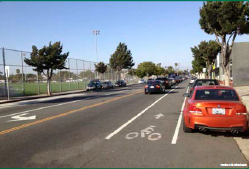 Ocean Park Boulevard looking east at 16th Street |
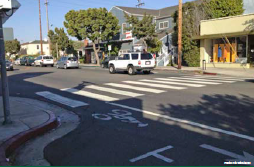 Ocean Park Boulevard looking east at 18th Street marked crosswalk and bicycle lane |
The main focus area of the Ocean Park Boulevard Road Diet was a short segment from 16th Street to 18th Street, which includes the Will Rogers Elementary School, the John Adams Middle School, and recreational facilities. With such a high volume of student activity in this area, vehicle speeds and a recent increase in crashes were concerning for parents, school faculty, and nearby residents. It became apparent to city officials that additional safety improvements were necessary since previous efforts such as adding crossing guards, flashing crosswalks, and speed feedback signs had little influence on speeding and the number of crashes.1
In the first 9 months following the reconfiguration, collision data indicated there was a 65 percent reduction (from 35 to 12 crashes), as compared to the same 9-month period in the year prior to the Road Diet installation. Injury collisions were reduced by 60 percent following the reconfiguration.
Travel speeds, based on statistics from the local transit provider in the corridor, have generally remained constant throughout the day. The 85th percentile speed within the Road Diet is at or below 27 mph, and speeds are approximately 10 mph higher outside the Road Diet limits. Utilizing a survey available online and distributed by mail, the city gauged the community's sentiment on the Road Diet installation. Many people appreciated the improved conditions for bicyclists and pedestrians, but others were dissatisfied by delays and a perception that the reconfiguration caused motorists to shift onto parallel streets.
The city collected traffic counts on Ocean Park Boulevard and the nearby roadways. Volumes on Ocean Park Boulevard decreased by approximately 3,000-4,500 vehicles per day after the conversion. The city's analysis was inconclusive on where these trips shifted. Some of the vehicles appeared to move to I-10 Freeway, but traffic counts showed the volumes on nearby local streets have been relatively stable.
Because of the resulting safety improvements and reduction of speed, the city made the decision in 2010 to retain the Road Diet configuration permanently as part of a resurfacing project along Ocean Park Boulevard.
ROAD DIET: KEY INGREDIENT IN LOS ANGELES' BICYCLE MASTER PLAN
| Objective | Features | Results |
|---|---|---|
|
|
|
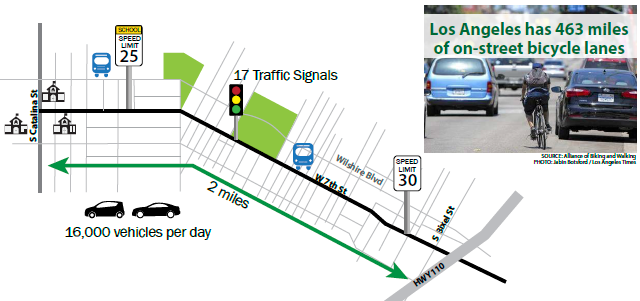

In 2011, the Los Angeles Department of Transportation (LADOT) completed a Road Diet on Seventh Street in order to install bicycle lanes along this east-west arterial just west of downtown Los Angeles from Bixel Street to Catalina Street. With traffic volumes of approximately 16,000 vehicles per day and a high number of pedestrians and bicyclists, this corridor is busy with several transportation modes.
This 2-mile stretch of Seventh Street contains 17 traffic signals and serves numerous metro bus routes. The land use is mainly multi-family residential and commercial, with several large parks along the corridor. A high school is located on the west end, and there are two middle schools nearby. The speed limit for the roadway is 30 mph except in areas where there are 25 mph school speed zones.
The City of Los Angeles developed a Bicycle Master Plan that provides direction for improving bicycle mobility and encouraging more bicycle ridership by expanding the existing bikeway network and improving connectivity. As a result of this Bicycle Master Plan, the installation of bicycle lanes is a major driving force for Road Diets in Los Angeles, but the overarching goal for the conversions is safety.
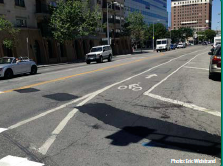 7th Street looking west at Bixel Avenue |
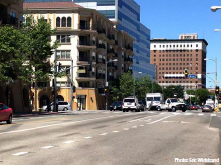 7th Street looking west at Bixel Avenue |
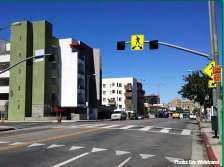 7th Street looking west at Coronado |
Prior to the implementation of the Road Diet, LADOT prepared a presentation that discussed expected benefits to safety, traffic calming, non-motorized accessibility, business access, and community health. LADOT discovered that emphasizing the safety benefits of Road Diets is important in gaining public acceptance.
Each corridor is unique, and LADOT found that working with their city council was essential to beginning a successful outreach process. The Los Angeles County Bicycle Coalition and other bicycle activists and community leaders strongly supported the project and assisted in the community outreach.1
After the completion of the Seventh Street Road Diet, LADOT received positive feedback from users, and a before-and-after bicycle count conducted by the Los Angeles County Bicycle Coalition showed that bicycle use in the corridor tripled once the Road Diet and new bicycle lanes were completed. LADOT also conducted some traffic analyses at several key intersections along the corridor and found that the results were satisfactory.
ALL-AROUND SUCCESS FOR SAFETY AND OPERATIONS
| Objective | Features | Results |
|---|---|---|
|
|
|


As part of a scheduled repaving project, the Virginia Department of Transportation (VDOT) implemented a Road Diet on a 2-mile section of Lawyers Road in Reston, Virginia, extending from Fox Mill Road to Myrtle Lane. Prior to the installation, Lawyers Road had two lanes in each direction; after the Road Diet, the corridor has one travel lane and a bicycle lane in each direction, separated by a two-way left-turn lane.
The land use on Lawyers Road is low-density residential with mostly single family homes and relatively long segments between intersections. There are no curbs or sidewalks through this area, and the traffic volume is approximately 10,000 vehicles per day.
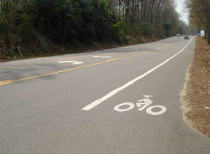 |
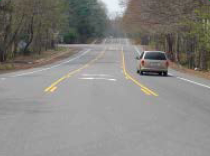 |
 |
| Road Diet Treatment on Lawyers Road | ||
VDOT planned to repave Lawyers Road in 2009 and took that opportunity to evaluate the feasibility of a Road Diet along this roadway. A 2-mile segment was identified, and VDOT's evaluation concluded that the traffic volumes in this area would be accommodated easily with a 3-lane section. After analyzing the crash types that were occurring between Fox Mill Road and Myrtle Lane, VDOT determined that a number of the crashes occurring could be addressed with a Road Diet conversion. Rear-end crashes involving vehicles waiting to turn left from the left through lane is one crash type that can be mitigated when converting a 4-lane roadway into a 3-lane roadway.
Prior to implementation, VDOT discussed the proposed Road Diet at community meetings to answer residents' questions and solicit feedback. Despite some concerns regarding potential traffic congestion and feelings that bicycle lanes were unnecessary on the corridor, many supported the Road Diet conversion. Bicyclists favored the 5-ft bicycle lanes proposed in the Road Diet, which would improve their overall safety and connectivity in the area.
A before/after analysis of speeds confirmed that operating speeds were reduced after Road Diet implementation. In response, VDOT lowered the speed limit on the 2-mile section of Lawyers Road from 45 mph to 40 mph.
Five years after the Road Diet conversion, a safety study revealed a 70 percent reduction in crashes between Fox Mill Road and Myrtle Lane.
In Fall 2010, VDOT conducted a survey to gauge the community's thoughts regarding the Road Diet on Lawyers Road. The key findings are summarized below:1
THERE'S MORE THAN ONE WAY TO COMPLETE A ROAD DIET
| Objective | Features | Results |
|---|---|---|
|
|
|
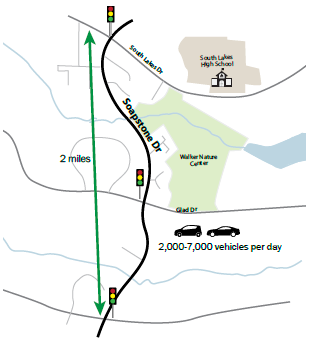
The success of the Road Diet on Lawyers Road convinced the Virginia Department of Transportation (VDOT) to try their second conversion on nearby Soapstone Drive. VDOT once again took advantage of a regularly-scheduled repaving project to implement the Road Diet which stretched from Sunrise Valley Drive to Lawyers Road. Carrying 2,000 to 7,000 vehicles per day, the cross section, land use, and speed limit vary on this nearly 2-mile segment of Soapstone Road, requiring a number of different reconfigurations along the corridor.
The most typical Road Diet conversion transforms a roadway with two lanes in each direction to a road with a single lane in each direction and a center turn lane, with the extra space often being used for bicycle lanes or parking. VDOT's Road Diet on Soapstone Road highlights a variety of ways a Road Diet can be implemented.
This 35 mph section of Soapstone Drive is more urban than the following segments, with sidewalks, multi-family housing, and light retail. A golf course and an elementary school are located nearby.

South Lakes Drive to Glade Drive has a wider cross-section and is located adjacent to the Walker Nature Center. With a mix of multifamily housing and commercial activity on one end and woodland areas and single family homes on the other, this middle section is transitioning from urban to a slightly rural feel.

While not a traditional Road Diet, VDOT restriped 18-ft lanes down to 12-ft and carried the bicycle lanes throughout. With a speed limit of 25 mph, this section of Soapstone Road includes low-density residential neighborhoods with single family homes. The surrounding land contains woodland areas and parks with recreational trails that attract pedestrian and bicycle traffic.

"A big thank you to VDOT for having the vision to modify Soapstone and Lawyers, making both roads safer for everyone and creating dedicated bike facilities for cyclists."1
FABB Blog: Fairfax Advocates for Better Bicycling
IMPROVING SAFETY AND LIVABILITY
| Objective | Features | Results |
|---|---|---|
|
|
|
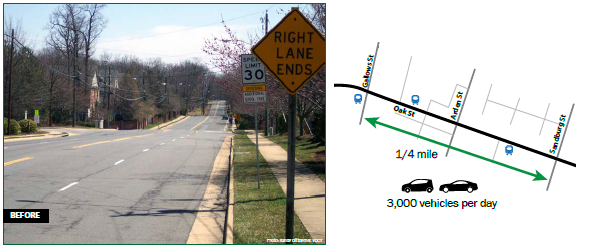
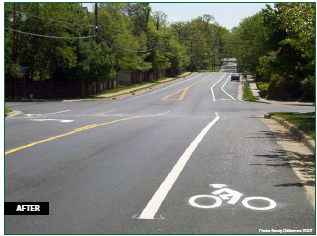
With hopes of providing a more consistent lane configuration and eliminating the most egregious speeding violations, the Virginia Department of Transportation (VDOT) implemented a Road Diet on a ¼-mile segment of Oak Street between Gallows Road and Sandburg Street.
Traffic volumes along this section of Oak Street are approximately 3,000 vehicles per day, and the surrounding neighborhood is mainly residential with single- and multi-family housing.
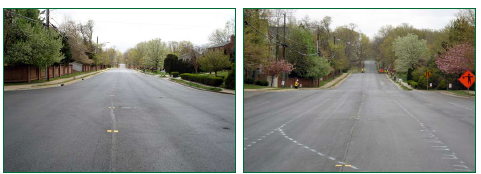
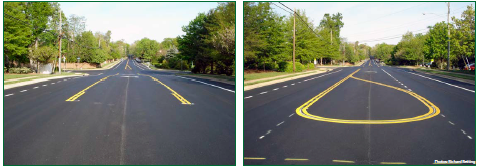
This roadway had an uncomfortable transition, and circumstances required an overlay due to wear. VDOT used that opportunity to fix the transition with a Road Diet, which also brought about safety and livability benefits.
Prior to the Road Diet, this 4-lane section of Oak Street ended abruptly just east of Sandburg Street, transitioning to a 2-lane roadway. This sudden lane drop often caused confusion for unfamiliar motorists in the area. In the 4-lane section, speeding and aggressive drivers often used the extra through lane in order to weave through traffic.
When a parallel street was temporarily closed for a bridge replacement, Oak Street absorbed a substantial increase in traffic volume, which accelerated the wear on its pavement. VDOT took advantage of the unplanned resurfacing to quickly design and implement a Road Diet, taking this 4-lane section of Oak Street to a 3-lane roadway with bicycle lanes and on-street parking.
While Oak Street had averaged less than a single crash per year in this short segment before the Road Diet was installed, VDOT is pleased to report that there have been no crashes in the first year following the project's completion in 2013.
"Through this Road Diet, we've been able to create center turn lanes, bike lanes, and on-street parking, all of which helped improve the safety and livability of the roadway," said Randy Dittberner of VDOT.
TEMPORARY ROAD DIET BECOMES PERMANENT
| Objective | Features | Results |
|---|---|---|
|
|
|


In 2010, the City of Des Moines, decided to "try out" a Road Diet on 4-lane Ingersoll Avenue between Polk Boulevard and Martin Luther King Jr. Parkway for a trial period. The 2-mile long Road Diet was implemented primarily as a Context Sensitive Solution (CSS) project to enhance the business environment with traffic calming, improve pedestrian and bicycle access, and add landscaping.
We were critical of the Des Moines City Council for its decision to approve the restriping of Ingersoll Avenue to change it from four lanes to three lanes...On all accounts, we were wrong. Our concerns proved to be unwarranted.
Cityview, Central Iowa's Independent Weekly1
Carrying 11,000 to 17,000 vehicles per day and serving as a transit bus route, Ingersoll Avenue is primarily developed with small, locally owned retail stores and restaurants. After the completion of the Road Diet, the final cross section included a 3-lane roadway with parking and bicycle lanes in both directions. The city provided right-turn lanes at the signalized intersections by prohibiting parking prior to the traffic signal.
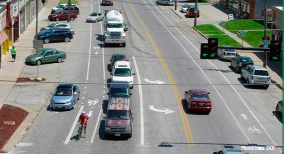
COMMUNITY CONCERNS
The community initially expressed concerns about a potential Road Diet, mostly centered on reducing traffic lanes to accommodate bicyclists. Critics were worried the Road Diet would cause more congestion, thereby encouraging motorists to avoid the area and hurting the businesses along Ingersoll. The community was also worried the change could result in an increase in crashes. The city's response was to offer a 6-month trial period for the Road Diet. If the public's concerns came to fruition, then the city would happily convert Ingersoll back to a 4-lane roadway.
Six months after the conversion, no major traffic problems had developed during the Ingersoll Avenue Road Diet. Although the Road Diet was not initially proposed and promoted as a safety improvement project, a simple before-and-after crash study revealed a 50 percent reduction in crashes.
Overall, traffic volumes did not decrease. In fact, there was a 5 percent increase in traffic from 11:00 AM to 1:00 PM, which suggests that motorists found the Ingersoll corridor to be more comfortable and inviting during their lunchtime.
The city conducted an online survey to gauge the public's view of the Road Diet after implementation. Although there remained some opposition, the results revealed that fewer people opposed the project after implementation than when the project was first proposed, and a majority favored keeping the Road Diet and felt the road was safer.
As a result of these findings, the Des Moines City Council voted to retain the Ingersoll Avenue Road Diet.
EDUCATING THE PUBLIC ON ROAD DIETS
| Objective | Features | Results |
|---|---|---|
|
|
|
The Regional Transportation Commission (RTC) of Washoe County has implemented many Road Diets within the City of Reno to allow for the addition of bicycle lanes. These projects were created as part of the Complete Street initiative to stimulate economic development and improve citizens' quality of life. The RTC has been proactive in educating the public during the entire process of implementing Road Diets. Once projects are complete, the RTC also publicizes the annualized crash rates1 for the road segments which have undergone the Road Diet treatment. This increases the public's understanding of the safety benefits.
The flyer provides answers to the most frequently asked questions:
The Road Diet provides opportunities to increase on-street parking, which benefits motorists and businesses. The safety and improved flow are especially beneficial on roads like California and Arlington with lots of driveways and side streets. Moving the people making turns out of the traffic stream improves flow and reduces rear end collisions.
Excerpt from RTC's public outreach flyer, Road Diets, Sharrows and Shared Lanes
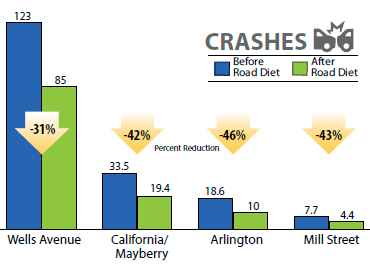
In an effort to promote safety, the flyer provides additional safety tips for bicyclists and motorists as they adjust to sharing the same lanes. These tips include reminding bicyclists that they are required to obey traffic laws and traffic control devices and encouraging them to ride predictably and to consider when drivers may or may not see them (e.g., passing traffic on the right-hand side or entering intersections when a driver's view may be obstructed). Other safety tips include suggesting motorists leave 3 feet of lateral space when passing a bicyclist, being aware of bicyclists when turning right across a bicycle lane, and checking for bicyclists before opening car doors on street-side parking.
The RTC's approach to Road Diet public education and outreach has been a key component in the success of their projects and has allowed them to continue to implement Road Diet treatments in Reno.
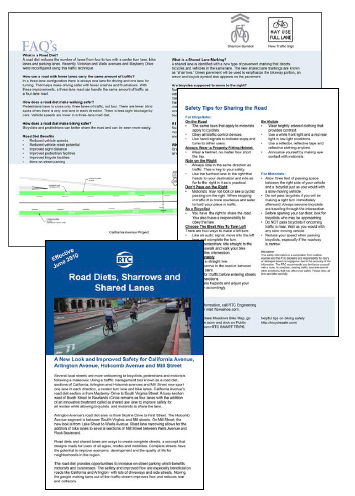
|
|
Experimenting with green-colored pavement in a continuous, longitudinal manner in conjunction with the shared-lane marking remains discontinued at this time. More information on the FHWA's active official experiments for green-colored pavement to communicate a continuous, longitudinal direction in conjunction with shared-lane markings can be found at the following websites: https://www.fhwa.dot.gov/environment/bicycle_pedestrian/guidance/design_guidance/ mutcd/ gcp_slm.cfm and the MUTCD Official Rulings Database at http://mutcd.fhwa.dot.gov/orsearch.asp | |
A FEASIBILITY EVALUATION USING TRAFFIC SIMULATION SOFTWARE
| Objective | Features | Results |
|---|---|---|
|
|
|
The Regional Transportation Commission (RTC) of Washoe County installed a Road Diet on California Avenue between Mayberry Drive and South Virginia Street in Reno, Nevada. To evaluate the feasibility of completing the Road Diet and to evaluate its impact on the existing traffic flow, the RTC used traffic simulation software.
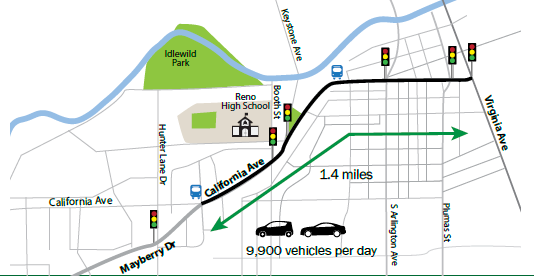
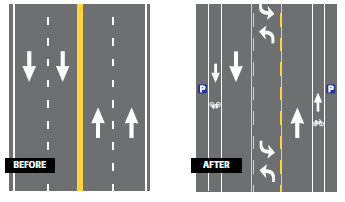
RESEARCH PLAN
Researchers collected 24-hour directional volume counts and spot speed data at three locations along California Avenue. Additionally, turning movement counts were manually collected at all intersections along the study corridor in order to collect baseline levels of service at each intersection. The researchers utilized simulation software to mimic the intended roadway configuration after the Road Diet and its effect on traffic. Future traffic growth was not considered in the analysis in order to have a direct one-to- one comparison of before-and-after level of service outcomes.
PROCEDURE
Researchers followed a four-step process for completing the Road Diet simulation.
1. Collection of traffic counts
The research team collected one week of 24-hour directional traffic volume counts using tube-counters at three locations along the proposed segment.
2. Collection of speed data
The research team collected spot speed data at the same three locations as the traffic counts. The team determined the 50th and 85th percentile speeds as inputs to the simulation data.
3. Collection of turning movement data at signalized intersections
Researchers obtained manual turning movement counts during morning and evening peak hours at intersections along the proposed segment. This data was used to determine the level of service (LOS) of the intersections before the Road Diet conversion.
4. Simulation analysis
Researchers simulated the Road Diet conditions at two combined intersections and at the access points. For the purpose of the simulation, the access points were treated as two-way stop-controlled intersections.
The intersections experienced unchanged LOS or dropped by one LOS category (e.g., from LOS B to C). The outcome of the simulation indicated that none of the intersections dropped below LOS D.
| Intersection | a.m. peak hour | p.m. peak hour | ||||||
|---|---|---|---|---|---|---|---|---|
| Existing | Future | Existing | Future | |||||
| LOS | V/C | LOS | V/C | LOS | V/C | LOS | V/C | |
| Booth St. | B | 0.77 | C | 0.84 | B | 0.30 | C | 0.43 |
| Keystone Ave. | B | 0.76 | C | 0.88 | B | 0.53 | C | 0.69 |
| S. Arlington Ave/ Clay St. | B | 0.11 | C | 0.13 | C | 0.53 | D | 0.87 |
| S. Sierra St. | A | 0.49 | A | 0.58 | A | 0.58 | B | 0.73 |
| S. Virginia St. | A | 0.37 | A | 0.37 | B | 0.43 | B | 0.43 |
Overall, the results showed that implementation of a Road Diet along this section of road would likely reduce the overall LOS, but only to a level still deemed acceptable by the RTC of Washoe County. Based on this finding, the RTC concluded that the traffic simulation analysis provided enough support to proceed with the Road Diet, and it was implemented in 2010.
ROAD DIET IMPROVES SAFETY FOR MOTORIZED AND NON-MOTORIZED USERS
| Objective | Features | Results |
|---|---|---|
|
|
|
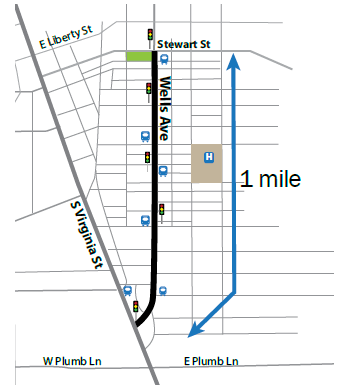 |
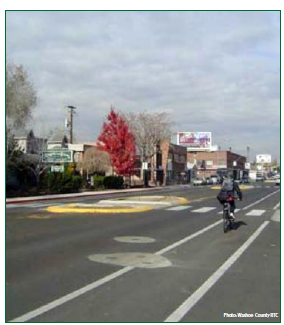 Wells Avenue after the completion of the Road Diet. |
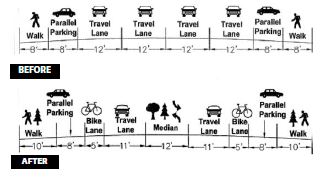
In 2003, the Regional Transportation Commission (RTC) of Washoe County installed a Road Diet on Wells Avenue between Stewart Street and South Virginia Street in Reno, Nevada. This section of Wells Avenue spans mostly commercial property. The original 4-lane cross section of Wells Avenue was converted to one vehicle lane in each direction, a center turn lane, a dedicated bicycle lane on each side, and wider sidewalks. The modification maintained the existing on-street parking on the corridor.
IMPLEMENTATION PLAN
The Road Diet on Wells Avenue was completed as a part of the RTC's Complete Streets initiative. The reconfiguration allowed for the addition of bicycle lanes and designated parking lanes, and the design integrated safety features such as curb extensions, frequent crossing opportunities, medians, pedestrian refuge islands, and lighting. To improve the aesthetics and livability of the corridor, the RTC also incorporated landscaping, benches, and public art into the project.
Two years after the completion of the Road Diet along Wells Avenue, the RTC reported the reductions in crashes were most evident in rear-end, angle, and overtaking sideswipe crashes, which were the most common crash types prior to the modifications. The Road Diet is also credited with reducing the number of pedestrian crashes by 54 percent.
| Crash Type | Before | After |
|---|---|---|
| Angle | 33 | 19 |
| Pedestrian | 13 | 6 |
| Rear End | 52 | 43 |
| Sideswipe, Overtaking | 13 | 4 |
| Head On | 0 | 2 |
| Sideswipe, Meeting | 0 | 3 |
| Rear-to-rear | 0 | 1 |
| Backing | 0 | 2 |
| Unknown | 12 | 5 |
| TOTAL | 123 | 85 |
After the Road Diet, average traffic speeds had decreased between 5 and 9 miles per hour (14-24 percent reduction).
The roadway segment also experienced an approximate 10 percent drop in traffic volume (from 15,854 to 14,244 vehicles/day). Although RTC has not confirmed that the traffic has shifted to parallel streets, this sometimes occurs when a road undergoes a Road Diet.
The RTC reported no change to the road's level of service after the Road Diet implementation. The RTC speculates that this is likely due to the existence of exclusive left-turn lanes at signalized intersections. At unsignalized intersections, the exclusive two-lane left-turn lane provides improved service to main street left-turn and side street left-turn traffic.
SAFETY SOLUTION NEAR SCHOOL IS A ROAD DIET
| Objective | Features | Results |
|---|---|---|
|
|
|
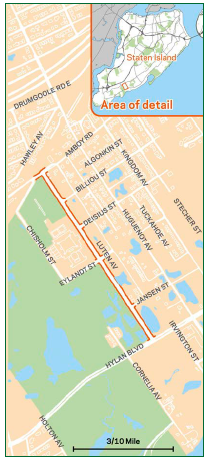
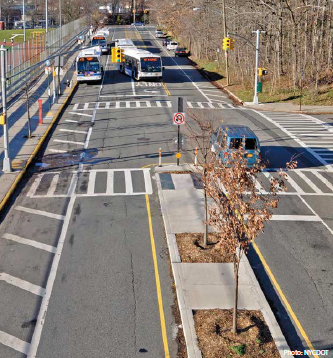
The New York City Department of Transportation (NYCDOT) utilized the Road Diet concept to address safety issues along Luten Avenue in Staten Island by converting a 4-lane roadway to a 2-lane roadway with a center median and parking lanes.
With Luten Avenue running parallel to both Tottenville High School property and Wolfes Pond Park, the area experiences heavy pedestrian activity, especially during school hours and after school activities. The east side of Luten Avenue contains mainly dense vegetation with some access to residential areas.
A tragic fatal crash involving a student pedestrian brought the NYCDOT, the Staten Island Community Board 3 (CB3), Tottenville High School, and other community groups together to formulate a plan for implementing safety strategies along Luten Avenue. They needed a treatment to reduce excessive speeds and to provide for safer pedestrian crossings.
NYCDOT used the information gained from these meetings to develop a proposed Road Diet on Luten Avenue, reducing the through lanes in each direction from two to one. To further narrow the roadway and calm traffic, the project included a painted center median and parking lanes. To address pedestrian safety, the agency installed pedestrian refuge islands and crosswalks. Along with a new signal at the intersection of Deisius Street and Luten Avenue, NYCDOT provided left-turn lanes at intersections along the corridor to improve traffic operations.
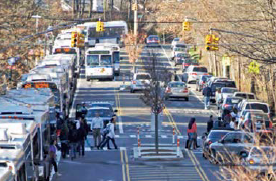 A Road Diet was installed along Luten Avenue to enhance safety for all road users. |
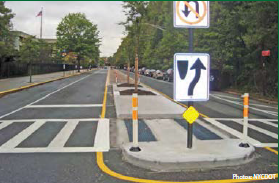 A pedestrian refuge island improves safety for pedestrians near Tottenville High School. |
NYCDOT reports that most segments along Luten Avenue have experienced reduced speeds due to the Road Diet, with a marked improvement of the vehicles traveling over the speed limit. The percentage of vehicles exceeding the speed limit decreased by 34 percent along southbound Luten Avenue and decreased by 21 percent in the northbound direction.
Crash data showed the number of crashes involving injuries to motor vehicle occupants and pedestrians after the Road Diet was lower than the average for the 3 years prior to project implementation.
| Before* (3 previous years) | After | |||
|---|---|---|---|---|
| 2007 | 2008 | 2009 | ||
| Total Crashes with Injuries | 6 | 2 | 2 | 2.3 |
| Number of Crashes with Injuries to Motor Vehicle Occupants | 5 | 1 | 0 | 1.7 |
| Number of Crashes with Injuries to Pedestrians | 1 | 1 | 2 | 0.6 |
| * Before columns show the crash history for each of the 3 years immediately prior to project implementation. After column shows number of crashes since implementation (through January 2012) at annual rate. | ||||
ROAD DIET ON ONE-WAY STREET DESIGNED FOR ALL USERS
| Objective | Features | Results |
|---|---|---|
|
|
|
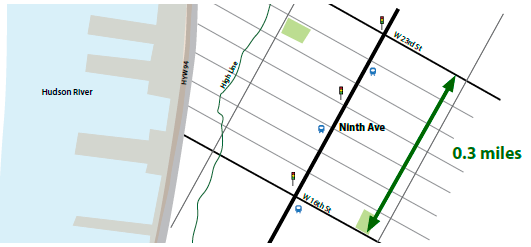
In 2007, New York City Department of Transportation (NYCDOT) implemented a Road Diet that completely redesigned Ninth Avenue. Prior to the reconfiguration, Ninth Avenue, a one-way street, consisted of four through lanes with parking on both sides, but no bicycle facilities and few pedestrian safety features. The redesign included three through lanes, a separated bicycle path located between the parking lane and sidewalk, and pedestrian refuge islands.

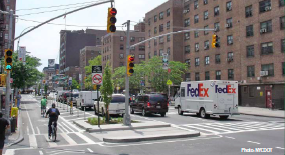 Bicycle lane, parking, and pedestrian refuge island on Ninth Avenue. |
Turning onto Ninth Avenue and heading down the bike lane was a spectacular experience – I immediately felt comfortable and safe, and my stress level decreased by orders of magnitude.1 |
PLANNING AND DESIGN
During the planning and design process, NYCDOT communicated openly to determine potential issues and address concerns from stakeholders and community representatives. The design considered the needs of all street users including bicyclists, pedestrians, motorists, bus riders, delivery persons, and emergency response personnel. Design considerations included the following:
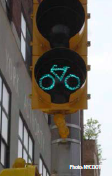
"The innovative design [on Ninth Avenue] has created a safe, comfortable, and unique street that will be the foundation for the future expansion of our bicycle network in heavily trafficked areas of our city", says NYCDOT. "This groundbreaking design is one that can be utilized by other jurisdictions to promote bicycling while providing safe streets for all users."2
In 2008, the Institute of Transportation Engineers (ITE) honored the success and creativity of NYCDOT's Road Diet project on Ninth Avenue by awarding it the Transportation Planning Council Best Program Award. The project's success was confirmed further in 2012 when NYCDOT reported that Ninth Avenue experienced a 58 percent decrease in injuries to all street users.3
1 Nick Grossman,"Ninth Avenue Gets a Physically Separated Bike Lane" Streetfilms Blog, October 3, 2007. Accessed March 19, 2015. Available at: http://www.streetfilms.org/ninth-avenue-gets-a-physically-separated-bike-lane/
2 R. Russo, R. Wade, J. Benson, C. Lucas, "Ninth Avenue Bicycle Path and Complete Street," page 6. Accessed March 19, 2015. Available at: http://www.nyc.gov/html/dot/downloads/pdf/rr_ite_08_9thave.PDF
3 New York City DOT, "Measuring the Street: New Metrics for 21st Century Streets" page 4. Accessed March 19, 2015. Available at: http://www.nyc.gov/html/dot/downloads/pdf/2012-10-measuring-the-street.pdf
ROAD DIET IMPROVES PEDESTRIAN SAFETY
| Objective | Features | Results |
|---|---|---|
|
|
|


In 2009, the New York City Department of Transportation (NYCDOT) implemented a Road Diet on Empire Boulevard between Utica Avenue and Bedford Avenue. The project aimed to increase pedestrian safety and comfort, calm traffic, and improve the aesthetic appeal of the overall streetscape.
The area surrounding Empire Boulevard is a mix of businesses, restaurants, and single-family and multi-family housing. There is a public school located on the east end of the corridor.
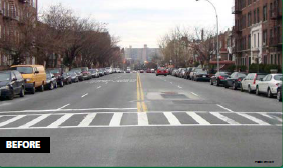 |
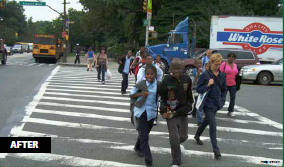 |
| Road Diet treatment on Empire Boulevard has significantly improved pedestrian safety. | |
SPEEDING AND PEDESTRIAN SAFETY
In 2007, the intersection of Empire Boulevard and Troy Avenue was listed as the second highest pedestrian crash location in New York City. Over the prior 10 years, the corridor had experienced a high proportion of mid-block crashes, including 6 fatalities and 33 serious injuries. NYCDOT found that the 85th percentile speeds during various times of day often exceeded the 30 mph statutory speed limit by 5-10 mph.
With data to support speeding and pedestrian safety concerns, NYCDOT sought changes for Empire Boulevard. The agency determined the existing 4-lane cross section was unnecessary for handling the traffic volumes occurring on Empire Boulevard. Since excessive capacity often encourages higher speeds, NYCDOT reduced the roadway cross section to two lanes (one in each direction) and allocated the extra space for bicycle lanes.
Under existing conditions, the length of the pedestrian crossing on Empire Boulevard was approximately 60 feet, with no raised medians to shelter pedestrians. The Road Diet plan included pedestrian refuge islands and shorter crossing paths. NYCDOT also added turn bays at intersections, preserved the parking spaces along Empire Boulevard, and improved the streetscape with trees and landscaping.
NYCDOT's Road Diet project improved safety for nearly all users. Pedestrian injuries decreased by 19 percent and overall crash injuries reduced by 27 percent. The area also experienced noticeable reductions in motor vehicle crashes and total crashes. Ultimately, the new layout improved both bicycle and pedestrian accessibility and comfort by reducing vehicle speeds and incorporating bicycle and pedestrian safety features into the streetscape.
| Before | After | Change | ||||||||
|---|---|---|---|---|---|---|---|---|---|---|
| ‘06 – ’07 | ‘07 – ’08 | ‘08 – ’09 | Average | ‘09 – ’10 | ‘10 – ’11 | ‘11 – ’12 | Average | Actual | Percent | |
| Total Crashes | 268 | 297 | 301 | 288.7 | 284 | 251 | 252 | 262.3 | -26.3 | -9% |
| Injuries | 88 | 77 | 74 | 79.7 | 73 | 62 | 67 | 67.3 | -12.3 | -15% |
| Motor Vehicle Occupant | 109 | 119 | 81 | 103.0 | 61 | 71 | 68 | 66.7 | -36.3 | -35% |
| Pedestrian | 35 | 29 | 19 | 27.7 | 28 | 21 | 18 | 22.3 | -5.3 | -19% |
| Cyclist | 4 | 5 | 3 | 4.0 | 10 | 8 | 10 | 9.3 | 5.3 | 133% |
| TOTAL INJURIES | 148 | 153 | 103 | 134.7 | 99 | 100 | 93 | 98.3 | -36.3 | -27% |
| Each before year is the 12-month period beginning June 1 and ending May 31. The 3-year after period is Sept. 1, 2009 to August 31, 2012. The implementation period of June 1, 2009 to August 31, 2009 is excluded. Source: NYPD AIS/TAMS Crash Database. | ||||||||||
NYCDOT RESPONDS TO TRAGEDY WITH ROAD DIET
| Objective | Features | Results |
|---|---|---|
|
|
|
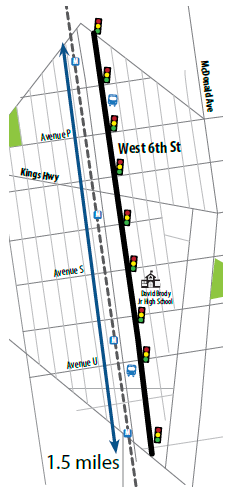
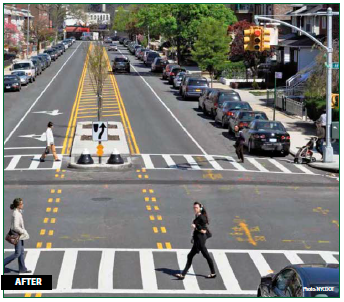
Following three pedestrian fatalities on the same roadway in Brooklyn, the New York City Department of Transportation (NYCDOT) conducted a study of West Sixth Street in November 2009. This 1.5-mile corridor carried fast-moving through traffic along with a high number of pedestrians heading to subway stations in the area. West Sixth Street was a 4-lane undivided arterial with excess capacity, long crossing distances for pedestrians, and significant separation between marked crosswalks, which led to illegal midblock crossings.
Located near residential neighborhoods, West Sixth Street runs parallel to the "N" subway train located one block to the west. There are four subway stops within the project corridor.
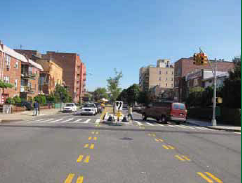 |
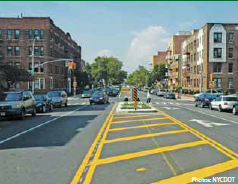 |
Crashes have been reduced and speeds have decreased along West Sixth Street since the Road Diet. |
THE PLAN
NYCDOT needed a solution to help calm traffic, reduce speeds, and improve pedestrian safety. Since West Sixth Street had excess capacity, NYCDOT adjusted the road to one vehicle lane in each direction and used the extra space to install a wide parking lane and painted median with left-turn bays at key intersections. At the locations with a high frequency of pedestrian crashes, the agency installed pedestrian refuge islands and high visibility crosswalk markings. The design and installation of the pedestrian refuge islands included prohibiting some left turns to reduce conflicts with pedestrians and opposing left turning traffic.
NYCDOT's plan effectively calmed traffic and improved safety along West Sixth Street. The agency analyzed crash data and performed speed studies along the corridor before and after the project was completed, with results indicating improved safety and speed reductions following the Road Diet. Overall average speeds on West Sixth Street decreased by 8 to 12 percent, and the percentage of vehicles exceeding the speed limit showed a reduction of nearly 30 percent in the northbound direction and more than 40 percent in the southbound direction. The before-and-after crash analysis revealed a reduction in the number of injury crashes after installation.
| BEFORE (three previous years) | AFTER | |||
|---|---|---|---|---|
| 2007 | 2008 | 2009 | ||
| Total Crashes with Injuries | 36 | 22 | 27 | 21.5 |
| Number of Crashes with Injuries to: Motor Vehicle Occupants | 15 | 11 | 14 | 8.8 |
| Number of Crashes with Injuries to: Pedestrian | 20 | 10 | 9 | 10.1 |
| Number of Crashes with Injuries to: Bicyclists | 1 | 1 | 4 | 2.5 |
| WEST 6TH STREET (Avenue V to Avenue W) | Average Traffic Speeds (m.p.h.) | Percentage of Vehicles Over the Speed Limit | ||
|---|---|---|---|---|
| BEFORE | AFTER | BEFORE | AFTER* | |
| Northbound | 30.4 | 27.9 | 53% | 34% |
| Southbound | 31.3 | 27.7 | 60% | 18% |
| *After column shows number of crashes since implementation (through Jan 2012) at annual rate. | ||||
TWO-STAGE ROAD DIET
| Objective | Features | Results |
|---|---|---|
|
|
|
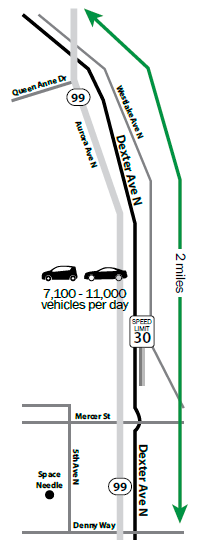
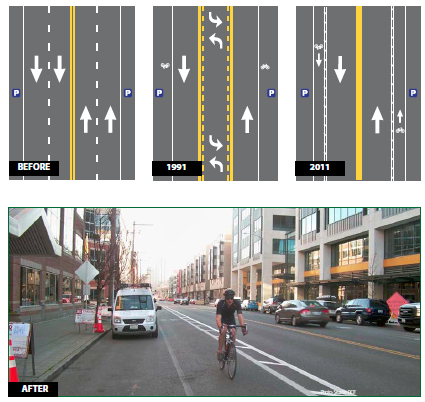
More than 20 years ago, Seattle Department of Transportation (SDOT) completed a Road Diet on Dexter Avenue, converting it from a 4-lane roadway to a 3-lane roadway with a bicycle lane in each direction. In 2011, SDOT revisited the design during a planned repaving project. With traffic volumes ranging from 7,100 to 11,000 vehicles per day and a low volume of left-turning vehicles, the SDOT determined a center left-turn lane was unnecessary. Therefore, SDOT went one step further on its original Dexter Avenue Road Diet and converted the 3-lane roadway to a 2-lane roadway with buffered bicycle lanes and bus bulbs.
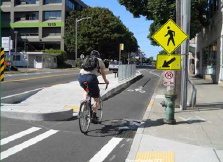 Bicycle lane and floating bus stop |
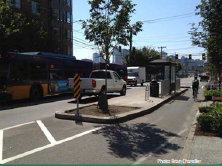 Transit and non-motorized users are prioritized on Dexter |
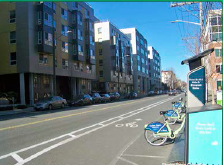 Bicycle rental station utilizes "extra space" |
Dexter Avenue runs north from Seattle's Belltown neighborhood, west of Lake Union. The street is located in a mixed-use area zoned for multi-family housing; the north end of the corridor contains primarily single-family homes.
THE DESIGN
Bicycle Lanes. Initially, SDOT considered parking-separated bicycle lanes on Dexter Avenue, but with a high driveway density and relatively steep grade of the roadway, there was a concern that sight distance and visibility could be a safety issue. As an alternative, SDOT placed the bicycle lanes adjacent to the travel lane separated by a 2-ft buffered area.
Transit. SDOT prioritized buses over general purpose traffic by moving several bus stops to in-lane, creating bus bulbs. The bicycle lanes were routed behind the bus stop pads towards the curb, creating "floating" bus stops.
Two-Way Left-turn Lane (TWLTL) Removal. With Aurora Avenue (Washington State Route 99) running parallel near Dexter Avenue on one side and a bluff on the other, there are very few left-turns onto side streets. This allowed SDOT to feel comfortable removing the TWLTL in the corridor. At the few places with significant left-turns, SDOT added left-turn pockets when the two-way left-turn lane (TWLTL) was removed.
Delivery Trucks. The TWLTL had been used by delivery trucks when loading and unloading, so there was concern about losing this space. SDOT added "Load Zones" on the route to address this need.
Public opinion on the Road Diet has been favorable, especially among bicyclists. Dexter Avenue is the primary bicycle corridor to reach downtown, with 300 southbound bicyclists per hour during the AM peak. During the same time, there are approximately 850 motorists per hour heading south. Transit travel times have remained consistent and bus ridership has increased by 30 percent between 2010 and 2013.
SAFETY IMPROVED & EXTREME SPEEDING VIRTUALLY ELIMINATED
| Objective | Features | Results |
|---|---|---|
|
|
|
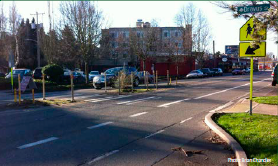

In August 2010, the Seattle Department of Transportation (SDOT) completed a Road Diet on Nickerson Street from 13th Avenue West to Florentia Street. The goal of this project was to improve pedestrian safety by reducing exposure to multiple lanes of traffic and increase driver compliance with the speed limit. Prior to the reconfiguration, there were two travel lanes in each direction. The street was restriped to one lane in each direction with a center two-way left-turn lane and bicycle lanes.
Carrying approximately 18,500 vehicles per day, Nickerson Street is in the Queen Anne neighborhood of Seattle. The corridor land use is mixed, including service-oriented businesses, restaurants, multi-unit residences, and the Seattle Pacific University campus.
 |
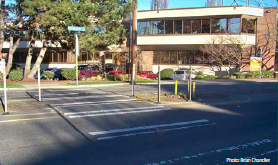 |
| To improve pedestrian safety, the Road Diet project incorporated crosswalks with curb bulb-outs and pedestrian refuge islands. | |
Prior to the Road Diet, SDOT was removing mid-block crosswalks on the city's 4-lane roads due to safety considerations. This decision was not popular with the community, and as a way of addressing the concerns, SDOT implemented the Nickerson Street Road Diet, which included the reintroduction of marked crosswalks and addition of curb bulb-outs and refuge islands. This configuration provides an opportunity for increased safety since pedestrians do not have to cross all lanes of traffic at once.
By decreasing the travel lanes to only one in each direction, SDOT also hoped to lower the speeds along Nickerson Street. In 2007, the agency completed a speed study and found that 90 percent of drivers were exceeding the 30 mph speed limit.
One year after the conversion, SDOT completed a before-and-after study on the Nickerson Street Road Diet. The outcome was what SDOT had hoped for – a safer road. Speeding along Nickerson Street decreased dramatically, and collisions were reduced. The results also showed that the Road Diet accomplished this without significant diversion of traffic to parallel routes. Nickerson Street only experienced a 1 percent decrease in traffic volumes between 2009 and 2011.
| Before | After | Change | |
|---|---|---|---|
| Westbound | 17% | 1.4% | -92% |
| Eastbound | 38% | 1.5% | -96% |
| 5-Year Average | One Year Post Project | Change |
|---|---|---|
| 33.6 | 26 | -23% |
DESPITE EARLY OPPOSITION, ROAD DIET PRODUCES GREAT RESULTS
| Objective | Features | Results |
|---|---|---|
|
|
|
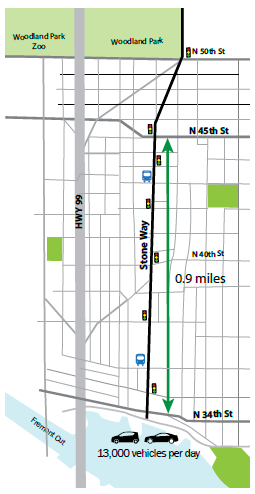
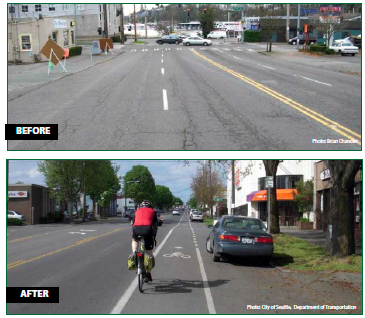
As part of a repaving project in 2007, Seattle Department of Transportation (SDOT) completed a Road Diet on Stone Way from 34th Street to 45th Street. It was the twenty-third lane reduction project undertaken by the city since 1972. Along with implementing the Stone Way Road Diet, the city also adopted a Bicycle Master Plan, which aimed to make Seattle the best community for bicycling in the United States.1 The Stone Way conversion supported this new initiative by adding bicycle lanes.
Connecting the Fremont and Wallingford neighborhoods in Seattle, Stone Way is a north-south arterial that carries approximately 13,000 vehicles per day and numerous Metro bus routes. There are many pedestrian generators in the area including parks, a trail, the Woodland Park Zoo, and several schools.
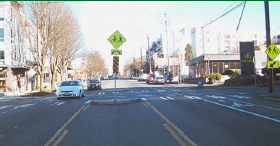 |
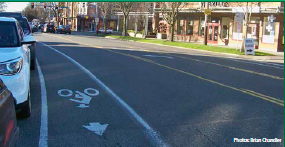 |
| The Stone Way Road Diet improved pedestrian and bicycle safety by incorporating pedestrian refuge islands and a combination of shared lanes and bicycle lanes. | |
Although the residents in Seattle were not strangers to Road Diets, there remained some strong opposition to the proposed Stone Way reconfiguration. Local business owners felt Stone Way is a vital arterial and should not be changed. "We need the road. We need to move traffic, particularly trucks. It's not a good idea to narrow the street down because traffic will overflow on other streets. This is our arterial. We want the four lanes of traffic."2
On the other hand, the bicycle activist community in Seattle vigorously supported the implementation of the project by organizing traffic counts, a demonstration ride, and commissioning an outside consultant report that asserted that undue congestion would not occur.3
In 2010, SDOT completed a before-and-after study to evaluate the effects of the Stone Way Road Diet. The results are as follows:4
1 City of Seattle, "Seattle Bicycle Master Plan," 2007.
2 S. Gilmore, "City Wants to Put Four-Lane Stone Way on Road Diet" The Seattle Times, October 12, 2006. Accessed March 23, 2015. Available at: http://www.seattletimes.com/seattle-news/city-wants-to-put-four-lane-stone-way-on-road-diet/
3 S. Ullman, "Stone Way: 1 of 34 Rightsizing Projects Making Seattle Safer and More Livable" Project for Public Spaces. Accessed March 23, 2015. Available at: http://www.pps.org/reference/stone-way-one-of-34-rightsizing-projects-making-seattle-safer-and-more-livable/
4 "Stone Way N Rechannelization: Before and After Study, N 34th Street to N 50th Street," City of Seattle Department of Transportation, May 2010
ROAD DIETS LEAD TO ECONOMIC DEVELOPMENT
| Objective | Features | Results |
|---|---|---|
|
|
|
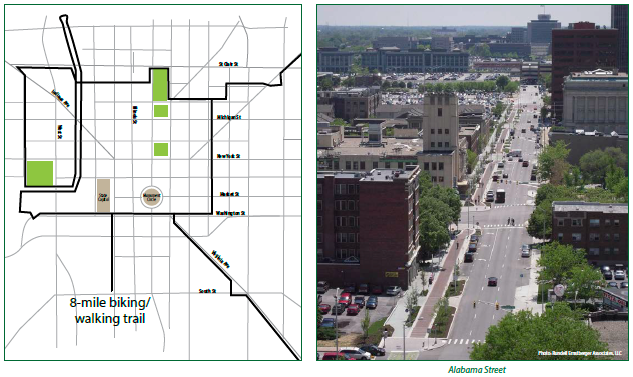
The City of Indianapolis, through a public-private partnership, completed the Indianapolis Cultural Trail, an 8-mile biking and walking trail system that connects the cultural districts, neighborhoods, and the city's greenway system. In order to complete this trail system, streets in downtown Indianapolis underwent Road Diets.
The streets in downtown Indianapolis were mostly five or six lanes wide, and speeds could reach close to 50 mph. The design team reduced both the number of lanes and lane widths as a way of both slowing speeds and gaining extra space within the right of way to allow for the separate pedestrian and bicyclist trail. The completed trail loops around downtown and connects to greenways with two spurs. The trail includes shared space for bicyclists and pedestrians, and some areas incorporate two separate facilities for pedestrians and bicyclists.
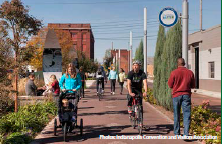 The ICT has brought a significant increase in pedestrian and bicycle traffic to downtown Indianapolis. |
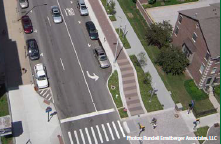 Pedestrian travel is separated from bicycle travel on this segment of ICT. |
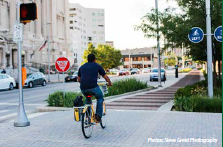 Riding the Pacers Bikeshare on the Cultural Trail. |
Central Indiana Community Foundation (CICF) and the Mayor of Indianapolis envisioned that by providing improved multi-modal connectivity throughout Indianapolis' cultural districts and historic neighborhoods, economic development in the area would improve. Leaders of the proposed trail project spent years explaining the potential benefits to politicians, philanthropists, and community officials and collecting private donations.
With the project consisting of seven phases and construction lasting almost 6 years, team members felt their commitment to public involvement and engagement throughout was a key component of the project's success. Early in the conceptual phase, the design team held a workshop to present the concept to the stakeholders. The team created a project website with up-to-date progress information and conducted many public meetings throughout the duration of the project.
Improving safety for all users was one of the project team's goals. In addition to the traffic calming effect the Road Diets provided, the design also included other safety features, such as curb bulb-outs at intersections to reduce crossing distance, chicanes in the bicycle facilities to alert bicyclists of an upcoming intersection, and countdown timers and audible pedestrian signals.
Although the last phase of the trail was not completed until the end of 2012, new construction and redevelopment started happening in the area well before the project was finished. Over $300 million of new development has been constructed along the route since 2008. While tax assessment data from 2007-2010 from nearby areas decreased by 1.2 percent, the assessed value along the Cultural Trail showed a small increase.
Using the Cultural Trail as its main marketing strategy, the visitor's bureau sees the trail's influence in downtown revitalization success. Vacant lots are being developed into restaurants and businesses. Local developers have opened several mixed-use, multi-family residential developments. This innovative redesign of the area has improved economic development and has brought a significant increase in pedestrian and bicycle traffic to downtown Indianapolis as people of all ages and abilities have embraced the trail.
